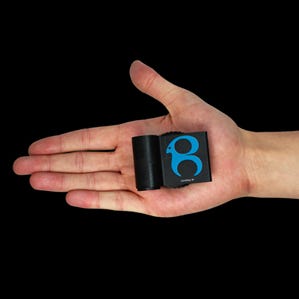January 30, 2015
|
Brown University's head-worn wireless brain-computer interface transmitter enables patients to control electronic devices with their thoughts. |
Research out of Brown University has yielded some of the most exciting results in brain-computer interface (BCI) technology yet, with the development of a new wireless transmitter that could give paralyzed patients a practical way to control various electronic devices with their thoughts.
A project that is nearly a decade in the making, researchers from Brown have teamed up with Blackrock Microsystems to commercialize a wireless device that can be attached to a person's skull and transmit via radio, various thought commands from a corresponding brain implant, according to a news release out of MIT. Blackrock reports that it will seek approval for the system from the FDA, so that testing can begin on volunteers as soon as this year.
Brown University is home to some of the country's leading innovators in BCI technology, and was among the first universities to place implants in the brains of paralyzed patients. The research was done in an effort to show that electrical signals emitted by neurons in the cortex could be recorded and used to direct a robotic arm. This has of course led to other ventures in mind-controlled robotics from other institutions, as researchers continue to look to push the envelope in BCI based technology. Researchers have even delved into the use of BCI technology to make human telepathy possible.
The latest development from Brown indicates a significant upgrade to previous versions of the technology. In the past, patients could only use this technology with the help of several lab assistants and techs that would operate various cables connecting bulky signal processors directly to a single port in the patient's skull. The cumbersome and anchored nature of the technology made it completely impractical, and borderline inconceivable to ever become useful to patients outside of a lab setting.
This new interface completely removes the tethered nature of the technology, by processing brain data inside a device roughly the size of a gas cap. The device is attached to the skull and wired to electrodes inside the brain. A processor is located inside the device to amplify the spikes emitted by neurons, before circuits digitize the information and relay it via a radio beam to a receiver. There, the information can be processed as a control signal that can execute commands such as moving a cursor across a computer screen, or steer wheelchair movements.
According to researchers, the device transmits data out of the brain at a rate of 48 megabits per second, which roughly equates to the speed of a residential internet connection. It is also battery powered, using only 30 mW of power, a mere fraction of what a normal smartphone uses.
For now, the technology will not be readily available until it is greatly simplified, and much more reliable and efficient at executing tasks with precision. The development of the wireless capabilities of this head-mounted module could serve as a significant step toward that goal. Blackrock has already begun selling the wireless processor, known as "Cereplex-W" to research labs that study primates. The owner and president of Blackrock says that tests in humans could be soon to follow, as Brown researchers plan to try it on paralyzed patients in the near future.
Refresh your medical device industry knowledge at MD&M West, in Anaheim, CA, February 10-12, 2015. |
Kristopher Sturgis is a contributor to Qmed and MPMN.
Like what you're reading? Subscribe to our daily e-newsletter.
About the Author(s)
You May Also Like



